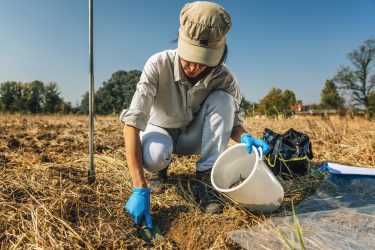Carbon standard to bring opportunities to regenerative food production
- Like
- Digg
- Del
- Tumblr
- VKontakte
- Buffer
- Love This
- Odnoklassniki
- Meneame
- Blogger
- Amazon
- Yahoo Mail
- Gmail
- AOL
- Newsvine
- HackerNews
- Evernote
- MySpace
- Mail.ru
- Viadeo
- Line
- Comments
- Yummly
- SMS
- Viber
- Telegram
- Subscribe
- Skype
- Facebook Messenger
- Kakao
- LiveJournal
- Yammer
- Edgar
- Fintel
- Mix
- Instapaper
- Copy Link
Posted: 16 August 2022 | Filippo Guerrini | No comments yet
The food and agriculture industries have an appetite for reducing carbon emissions, with many businesses setting their own goals to meet Net Zero. Filippo Guerrini from regenagri explains the critical role a ‘carbon standard’ can have in successfully reducing carbon emissions across the entire food supply chain.


regenagri offers support to brands and farmers looking to start using regenerative methods, either on their own farms, or for those in their supply chain. We operate globally and offer a digital hub for monitoring on-farm data and regenerative certification. Through this initiative, food brands have been able to offer assurance that the ingredients in their products have been produced using regenerative practices, but the latest addition to regenagri’s services is a regenerative carbon standard.
The standard is a set of guidelines on how to monitor and calculate the emissions and sequestration of carbon associated with the production of a food product. The aim is to generate carbon credits, which can then be traded in the global voluntary carbon market.
Why a carbon standard is essential
The need for a carbon standard has been partly driven by an increase in awareness of greenhouse gas dynamics in agriculture. Globally, agriculture, forestry and land use collectively contribute 18.4 percent of total greenhouse gas emissions,1 although this varies somewhat between countries, with 10 percent of UK greenhouse gas emissions coming from the sector.2
Meanwhile, corporates and brands in all sectors are under pressure to set and adhere to carbon emissions reduction targets – with the bar set at achieving Net Zero or aligned with the Paris Agreement.
In addition to evaluating their own operations, corporates can look at offsetting unavoidable emissions by purchasing carbon credits. This is effectively paying for a farmer to reduce their emissions and sequester carbon in their soil and trees, then incorporating these carbon savings into their own carbon footprint, thus enabling the business to reach Net Zero. A variation of this, which works particularly well for food brands, is insetting. This also involves the purchase of carbon credits, but the brand works with its own supply chain to address problems and fix them.
For the carbon market to work effectively, there must be guidelines for farms to adhere to, plus the monitoring and measurement of emissions reduction as well as quantifying the carbon stored on farms. Emissions savings and stored carbon must then be verified to ensure independent vetting and the generation of a carbon credit. This is where carbon standards come in.
Using regenerative farming to achieve Net Zero
Farming is unique in that as well as reducing emissions, many regenerative farming practices enable removal of carbon from the atmosphere and storing it as organic material in soil.
For example, retaining green cover on the land, even after the commercial crop has been harvested, allows the capture of carbon from the air and conversion into organic material via photosynthesis to continue. Soil cover with plants also prevents loss of soil through erosion, as the plant roots provide structure.
A farm engaging with the regenagri regenerative carbon standard initially undergoes a thorough onboarding assessment. This builds an accurate picture


Agronomist taking soil sample for fertility analysis
of their potential to store carbon and enables a realistic and fair target to be set. Soil type, climate, plant species grown and the availability of nutrients all impact how much carbon can be stored in a farm’s soils, so it’s important to assess each of these factors.
Engaging with the carbon standard is a long-term commitment, with the option to commit for either 10 or 15 years. During this time, there will be continuous data monitoring and meetings with auditors to measure the outcome of the regenerative practices put in place. This involves measuring changes in soil organic matter over time and the growth rate of trees. The calculations on amount of carbon stored are based on a combination of the practices adopted and the measurements taken during auditing. The audits verify progress made and enable the generation of carbon credits.
Adhering to a carbon standard
In a world with an abundance of regulations around how food is produced, it‘s fair to ask why a farmer or brand should engage with a carbon standard.
For food producers the benefits are reaped by being able to legitimately sell the credit and finance their transition into a regenerative system. The changes required will often benefit their business in other ways; for example, through direct savings from reduced fuel use or by improving soil quality.
For a brand, the benefit comes through achieving Net Zero and being able to communicate how the food produced is contributing to the environment, for the benefit of the environmentally conscious consumer.
What are the challenges?
Currently the biggest hindrance to having more land managed in line with the carbon standard is the time it takes to roll out new projects. This time can be reduced by developing systems where groups of farms are onboarded together. This might be a group of farms all supplying one brand, or farms coming together in a cooperative, enabling auditors to work with the group, rather than each individual farm.
There are already 450,000 hectares of farmed land adhering to the regenerative carbon scheme. Currently, the biggest engagement has been from India, Brazil, Turkey, Europe, the UK and the USA. This is expected to grow, as the agricultural and food sectors realise that carbon credits are a viable way to fund a transition and bring about real change in terms of reducing emissions associated with food production.
About the author
Filippo Guerrini is regenagri’s Regenerative Agronomic Advisor. He joined the company at the beginning of 2021 as scientific advisor. His work focuses on the link between regenerative agriculture and quantitative gains of carbon sequestration, restoration of biodiversity and other ecosystem services.
Filippo holds a BSc in Agriculture from the University of Bologna (IT) and a MSc on Rural Development from Agrocampus Ouest (FR) with a thesis on ‘Transition to Regenerative Agriculture : Carbon sequestration potential and implementation of Payment for Ecosystem Services’.
References
- https://ourworldindata.org/emissions-by-sector
- www.gov.uk/government/statistics/agri-climate-report-2021/agri-climate-report-2021









